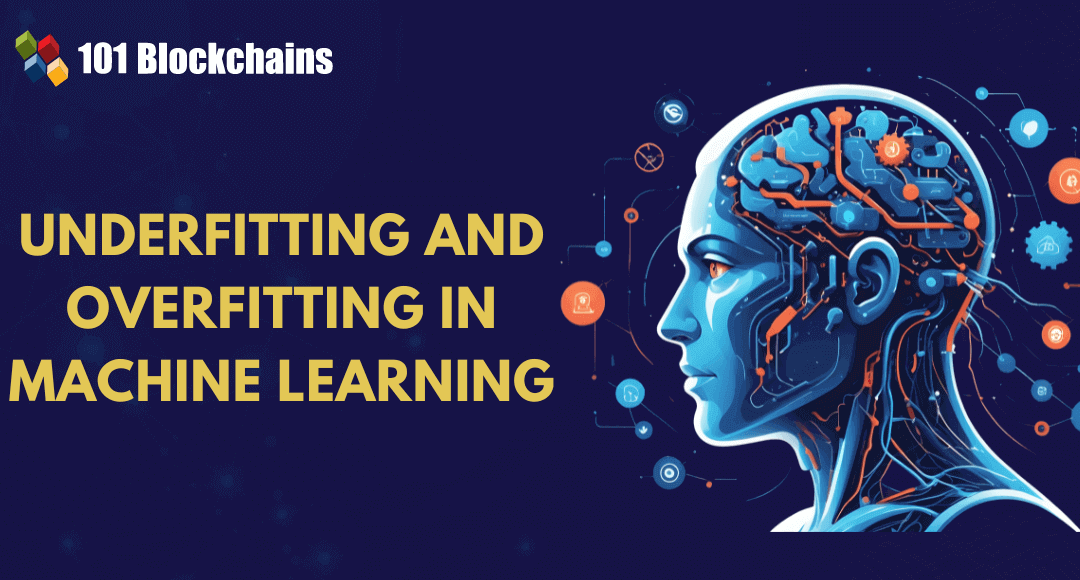Machine learning focuses on developing predictive models that can forecast the output for specific input data. ML engineers and developers use different steps to optimize the trained model. On top of it, they also determine the performance of different machine learning models by leveraging different parameters.
However, choosing a model with the best performance does not mean that you have to choose a model with the highest accuracy. You need to learn about underfitting and overfitting in machine learning to uncover the reasons behind poor performance of ML models.
Machine learning research involves the use of cross-validation and train-test splits to determine the performance of ML models on new data. Overfitting and underfitting represent the ability of a model to capture the interplay between input and output for the model. Let us learn more about overfitting and underfitting, their causes, potential solutions, and the differences between them.
Exploring the Impact of Generalization, Bias, and Variance
The ideal way to learn about overfitting and underfitting would involve a review of generalization, bias, and variance in machine learning. It is important to note that the principles of overfitting and underfitting in machine learning are closely related to generalization and bias-variance tradeoffs. Here is an overview of the crucial elements that are responsible for overfitting and underfitting in ML models.
Generalization refers to the effectiveness of an ML model in applying the concepts they learned to specific examples that were not a part of the training data. However, generalization is a tricky issue in the real world. ML models use three different types of datasets: training, validation, and testing sets. Generalization error points out the performance of an ML model on new cases, which is the sum of bias error and variance error. You must also account for irreducible errors that come from noise in the data, which is an important factor for generalization errors.
Bias is the result of errors due to extremely simple assumptions made by ML algorithms. In mathematical terms, bias in ML models is the average squared difference between model predictions and actual data. You can understand underfitting in machine learning by finding out models with higher bias errors. Some of the notable traits of models with higher bias include higher error rates, more generalization, and failure to capture relevant data trends. High-bias models are the most likely candidates for underfitting.
Variance is another prominent generalization error that emerges from the excessive sensitivity of ML models to subtle variations in training data. It represents the change in the performance of ML models during evaluation with respect to validation data. Variance is a crucial determinant of overfitting in machine learning, as high-variance models are more likely to be complex. For example, models with multiple degrees of freedom showcase higher variance. On top of that, high-variance models have more noise in the dataset, and they strive to ensure that all data points are close to each other.
Take your first step towards learning about artificial intelligence through AI Flashcards
Definition of Underfitting in ML Models
Underfitting refers to the scenario in which ML models cannot accurately capture the relationship between input and output variables. Therefore, it can lead to a higher error rate on the training dataset as well as new data. Underfitting happens due to over-simplification of a model that can happen due to a lack of regularization, more input features, and more training time. Underfitting in ML models leads to training errors and loss of performance due to the inability to capture dominant trends in the data.
The problem with underfitting in machine learning is that it does not allow the model to generalize effectively for new data. Therefore, the model is not suitable for prediction or classification tasks. On top of that, you are more likely to find underfitting in ML models with higher bias and lower variance. Interestingly, you can identify such behavior when you use the training dataset, thereby enabling easier identification of underfitted models.
Understand the actual potential of AI and the best practices for using AI tools with the AI For Business Course.
Definition of Overfitting in ML Models
Overfitting happens in machine learning when an algorithm has been trained closely or exactly according to its training dataset. It creates problems for a model in making accurate conclusions or predictions for any new data. Machine learning models use a sample dataset for training, and it has some implications for overfitting. If the model is extremely complex and trains for an extended period on the sample data, then it could learn the irrelevant information in the dataset.
The consequence of overfitting in machine learning revolves around the model memorizing the noise and fitting closely with the training data. As a result, it would end up showcasing errors for classification or prediction tasks. You can identify overfitting in ML models by checking higher variance and low error rates.
How Can You Detect Underfitting and Overfitting?
ML researchers, engineers, and developers can address the problems of underfitting and overfitting with proactive detection. You can take a look at the underlying causes for better identification. For example, one of the most common causes of overfitting is the misinterpretation of training data. Therefore, the model would lead to limited accuracy in results for new data even if overfitting leads to higher accuracy scores.
The meaning of underfitting and overfitting in machine learning also suggests that underfitted models cannot capture the relationship between input and output data due to over-simplification. As a result, underfitting leads to poor performance even with training datasets. Deploying overfitted and underfitted models can lead to losses for businesses and unreliable decisions. Take a look at the proven ways to detect overfitting and underfitting in ML models.
-
Finding Overfitted Models
You can explore opportunities to detect overfitting across different stages in the machine learning lifecycle. Plotting the training error and validation error can help identify when overfitting takes shape in an ML model. Some of the most effective techniques to detect overfitting include resampling techniques, such as k-fold-cross-validation. You can also hold back a validation set or choose other methods, such as using a simplistic model as a benchmark.
-
Finding Underfitted Models
The basic understanding of overfitting and underfitting in machine learning can help you detect the anomalies at the right time. You can find problems of underfitting by using two different methods. First of all, you must remember that the loss for training and validation will be significantly higher for underfitted models. Another method to detect underfitting involves plotting a graph with data points and a fixed curve. If the classifier curve is extremely simple, then you might have to worry about underfitting in the model.

How Can You Prevent Overfitting and Underfitting in ML Models?
Underfitting and overfitting have a significant influence on the performance of machine learning models. Therefore, it is important to know the best ways to deal with the problems before they cause any damage. Here are the trusted approaches for resolving underfitting and overfitting in ML models.
-
Fighting against Overfitting in ML Algorithms
You can find different ways to deal with overfitting in machine learning algorithms, such as adding more data or using data augmentation techniques. Removal of irrelevant aspects from the data can help in improving the model. On the other hand, you can also go for other techniques, such as regularization and ensembling.
-
Fighting against Underfitting in ML Algorithms
The best practices to address the problem of underfitting include allocating more time for training and eliminating noise from data. In addition, you can deal with underfitting in machine learning by choosing a more complex model or trying a different model. Adjustment of regularization parameters also helps in dealing with overfitting and underfitting.
Enroll now in the ChatGPT Fundamentals Course and dive into the world of prompt engineering with practical demonstrations.
Exploring the Difference between Overfitting and Underfitting
The fundamental concepts provide relevant answers to the question, “What is the difference between overfitting and underfitting machine learning?” on different parameters. For example, you can notice the differences in the methods used for detecting and curing underfitting and overfitting. Underfitting and overfitting are the prominent reasons behind lack of performance in ML models. You can understand the difference between them with the following example.
Let us assume that a school has appointed two substitute teachers to take classes in absence of regular teachers. One of the teachers, John, is an expert at mathematics, while the other teacher, Rick, has a good memory. Both the teachers were called up as substitutes when the science teacher did not turn up one day.
John, being an expert at mathematics, failed to answer some of the questions that students asked. On the other hand, Rick had memorized the lesson that he had to teach and could answer questions from the lesson. However, Rick failed to answer questions that were about complexly new topics.
In this example, you can notice that John has learned from a small part of the training data, i.e., mathematics only, thereby suggesting underfitting. On the other hand, Rick can perform well on the known instances and fails on new data, thereby suggesting overfitting.
Identify new ways to leverage the full potential of generative AI in business use cases and become an expert in generative AI technologies with Generative AI Skill Path
Final Words
The explanation for underfitting and overfitting in machine learning showcases how they can affect the performance and accuracy of ML algorithms. You are likely to encounter such problems due to the data used for training ML models. For example, underfitting is the result of training ML models on specific niche datasets.
On the other hand, overfitting happens when the ML models use the whole training dataset for learning and end up failing for new tasks. Learn more about underfitting and overfitting with the help of professional training courses and dive deeper into the domain of machine learning right away.









